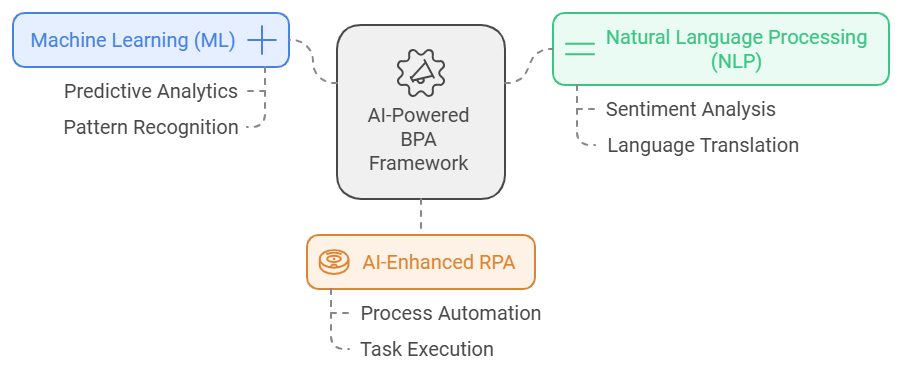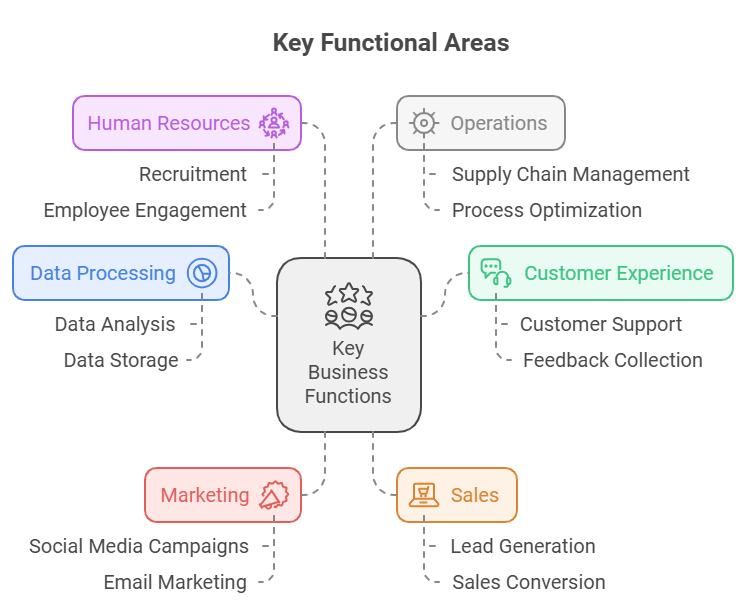How AI is Revolutionizing Business Process Automation
- Get link
- X
- Other Apps
Introduction: The Era of AI in Business Process Automation
Artificial Intelligence (AI) not only transforms business but is also entirely revolutionizing it. It will automate all the complex processes and supply unparalleled efficiency.
Keeping up with today’s fast digital pace turns out to be about the same when traditional methods just won’t cut it. Automation is becoming increasingly popular; businesses that integrate AI-driven solutions into their workflows are leveraging smarter automation to streamline processes and enhance decision-making. However, automation is no longer enough. Wherever AI prevails, business process automation (BPA) advances from simple task execution to a somewhat smarter, more adaptive approach.
In this blog, we will take you on a detailed ride about the inspirational role of AI in BPA. We’ll cover how businesses can leverage AI for business excellence derived from unmatched benefits and challenges, real-world applications, and future trends.
The Rise of Automation: Where AI Fits In
For years, business has been dependent on automation to perform the same set of tasks such as data entry, inventory management and customer support. On the downside, traditional automation is not flexible and does not react according to predefined rules.
Intelligence is injected in through AI – it bridges this gap. Using technologies such as machine learning, natural language processing (NLP), and cognitive computing, AI makes the machine’s systems capable of analyzing data, learning from patterns, and making decisions in real-time. The result is a combination of automation and intelligence that brings the static workflows to life with dynamics, evolving with business needs.
In this new era, AI-driven BPA is no longer a luxury, it’s a must have to survive in a world that is continually becoming more competitive and data driven.
What is Business Process Automation (BPA)?
Defining BPA
Business Process Automation is an application of technology that implements business processes that perform repetitive work and increase workflows without bringing much human intervention for better business performance. BPA frees employees from the manual time needed to complete an activity over and over (processing invoices, for example, instead of managing invoices, creating invoices) and lowers the time it takes to complete them, minimizing errors in the process.
By automating these processes, organizations can focus on what truly matters: customer satisfaction, long term growth and innovation.
Why Businesses Need BPA
- Reduced Operational Costs: This reduces expenses tremendously by reducing the time and effort necessary to complete routine activities. It gives businesses the ability to spend their resources better.
- Eliminated Errors and Redundancies: They are subject to (manual) mistakes and inefficiencies. By ensuring accuracy and consistency, BPA improves the overall process reliability.
- Freeing Human Resources: After this, time consuming work gets automated, leaving employees to spend their time on strategic, value adding work such as decision making and creative problem solving.
Traditional vs. AI-Powered Automation

Traditional automation has transformed repetitive task handling with finality, working within rigid rules. Say a rule-based system could be used to automatically trigger email reminders if there is a missed deadline.
Unlike traditional systems, RPA combined with AI offers dynamic and adaptable workflows capable of handling exceptions and learning from new data patterns. Here’s how:
| Aspect | Traditional Automation | AI-Powered Automation |
|---|---|---|
| Functionality | It runs fixed tasks according to rules. | It dynamically and from data learns. |
| Error Handling | Takes breaks or fails when unexpected events happen. | Responds intelligently to anomalies. |
| Scalability | Limited to programmed tasks. | It offers a continuous learning capability that expands capabilities and learning. |
| Decision-Making | Limited in decision-making capabilities. | It makes data-driven decisions on its own. |
BPA using AI enables businesses to embed intelligent workflows that evolve over time to become more efficient and provide personalized outcomes. The shift from static to dynamic processes is essential to survive today’s highly competitive environment.
The Role of AI in Transforming BPA
What is AI in the Context of Automation?
Artificial Intelligence (AI) in automation is a disruptive technology on which systems can base their intelligence. Improved workflows are helped by advanced tools like machine learning (ML), natural language processing (NLP), predictive analytics, etc, making AI capable of automating not just static, rule based workflows.
Unlike a pre-set instruction, AI driven systems analyze data, figuring from experiences and adapt to ever changing things. Such an environment provides the companies with the means to deploy smart and scalable solutions.
How AI Complements BPA
AI takes Business Process Automation to the next level by introducing three key capabilities:
Real-Time Data Analysis:
Processes are handled well by traditional automation, but real-time, large data is a problem. It fills this gap by quickly analyzing endless datasets and uncovering actionable insights. For example, AI in supply chain management can predict delays or as schedules change dynamically.
Learning and Adapting:
Machine learning-powered AI allows the automation system to learn from historical data. Later on, the system refines the accuracy and efficiency of the patterns it identified without needing any manual reprogramming.
Data-Driven Decision-Making:
There are plenty of places in which AI can do without human oversight. It analyses trends, considers options and makes autonomous decisions. Let’s say that an AI enabled HR system can screen resumes, pull out top candidates and schedule their interviews all itself.
Key Technologies Driving AI in BPA

Machine Learning (ML):
For businesses seeking customized software solutions, integrating machine learning can optimize workflows and predict trends effectively. For example, an ML model can be used to detect fraudulent transactions in the finance industry by looking at behavior.
Natural Language Processing (NLP):
NLP allows a system to interpret and respond to human language. NLP powers the use of AI chatbots and virtual assistants for customers who can get supported quicker than they wait for a response which is more accurate.
AI-Enhanced Robotic Process Automation (RPA):
RPA however is nothing but traditional and hence it fits in repetitive tasks only. But when combined with AI RPA becomes adaptive. With AI enriched RPA, exceptions can be handled, variations can be learned from and even improvements to the process suggested. Imagine the RPA system powered by an AI in health care that processes patient records, looks up for anomalies and recommends further diagnostic actions.
Comparison of the three technologies with their functions and use cases.
| Technology | Function | Example Applications |
|---|---|---|
| Machine Learning | Provides prediction of outcomes and optimizations of workflows. | Demand forecasting, fraud detection. |
| Natural Language Processing | Processes human communication and understands it. | Chatbots, email routing. |
| AI-Enhanced RPA | It learns and configures multiple workflows automatically. | Compliance checks invoice processing. |
Key Areas Where AI is Revolutionizing BPA

Yet, Artificial Intelligence is redefining the way businesses consider automation on the efficiency, accuracy, and flexibility axis. Below are the key areas where AI is making a profound impact on Business Process Automation (BPA):
Intelligent Data Processing and Analysis
Massive datasets, trends, and strategy suggestions are what AI does best. Data analysis automation allows businesses to fast and accurately make decisions taking into account the data.
Example:
The way AI works in financial auditing is that AI systems can look at massive transactional data snap shots in real time and flag any discrepancies or anomalies that need to be addressed, thereby helping to reduce human oversight.
Source: https://www.sigmasolve.com/blog/ai-in-business-process-automation/
- Get link
- X
- Other Apps



Comments
Post a Comment